Guineas may lay small eggs and not boast an especially tasty flavor, but these little poultry birds still bring copious amounts of value to a homestead. Keeping guineas on your land will help protect your meat and eggs birds and rid the area of destructive bugs… and snakes.
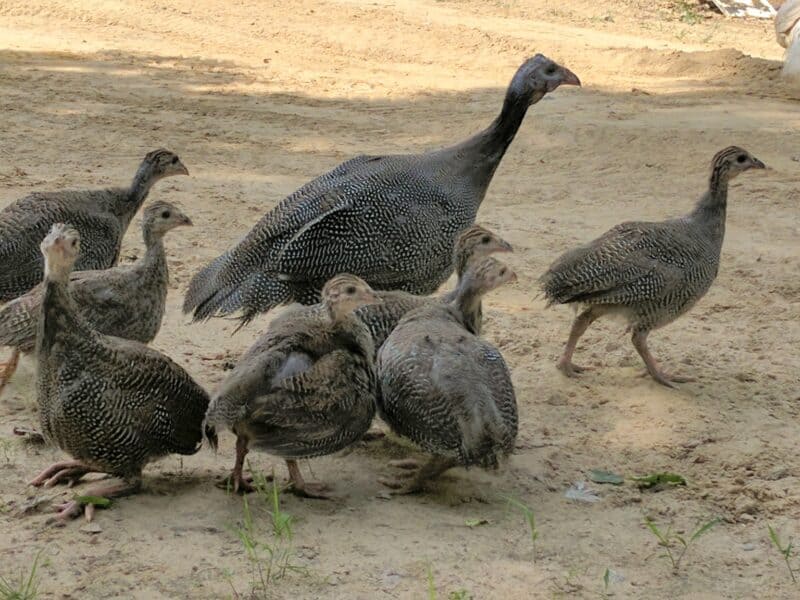
A guinea has just one job on a homestead: its feathered charges… and it excels at the task. There is absolutely no way a predator will get within 10 feet of your chicken coop without the flock of guineas sounding their high-pitched alarm squak.
Simply because guineas warn you about predators and immediately go into attack mode does not mean they always kill their prey without sustaining substantial losses to their own flock numbers.
When a pack of guineas take on a fox, bobcat, or some breeds of snakes, many or sometimes all of them will sacrifice their own lives to keep your flock safe.
Many homesteaders and farmers have long referred to guineas as “sacrificial lambs.” Even though part of running a farm or homestead involves losing or butchering animals, it is still difficult to bring home these weird looking little cuties as keets (baby guineas) and look at them as disposable weapons.
I prefer to think of our guineas as our “little assassins.” Sure, the end result will not be altered by using my turn of phrase, but it does make guineas sound more like the force to be reckoned with, and not merely bait.
Can You Eat Guineas?
Yes, but you will get meat that is a little tough and not much of it. They are also often dubbed the “poor man’s pheasant” due to the type and amount of meat they produce.
Still, if you are both a homesteader and a prepper, it is good to have an extra meat source roaming around your land. Not only will guineas alert you to the presence of a chicken coop predator, they will also make sure you know if a human threat abounds as well.
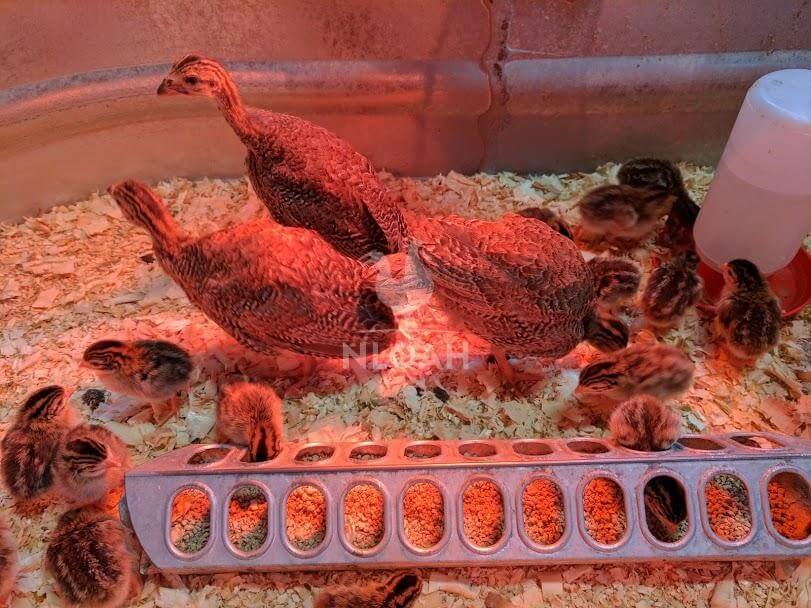
This type of chick starter feeder is commonly used in poultry bird brooders. While it holds a lot of feed and is sturdy, it is also messy. As you can see in the image above, the guinea keets are small enough to climb inside, or walk on their feed with feet that have also walked over their own feces.
Most breeds of day young chicks can do the same. Feeders of this type also invite the little birds to perch on them – hence fresh droppings falling directly inside.
Guineas are West African natives and have adapted to environments all around the globe. Guineas are identified by their color instead of breed and classified as either standard or jumbo varieties.
Guinea Pearl birds are the most common variety found in America, and the type I keep.
Keets typically range in price from $7 to $10 each, and mature birds cost about $20 to $25 regardless of whether they are hens or cocks. gender is nearly impossible to determine in guineas unless you see a host of recently hatched keets trailing behind their momma hen.
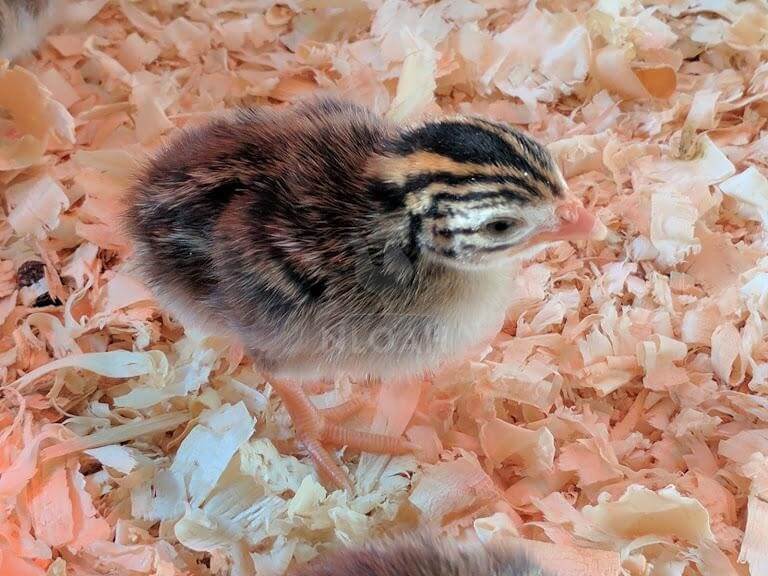
Top 3 Reasons You Should Keep Guineas
- They eat ticks, massive amounts of ticks.
- Even if your chicken coop is an acre or two away from your home, it would be nearly impossible not to hear a flock of guineas warning a threat is present.
- If you can keep the fragile guinea keets alive until they reach the juvenile stage, they are far less vulnerable to common poultry bird illnesses than most breeds of ducks, chickens, and turkeys.
Guinea Quick Facts
- Jumbo guineas usually weigh between 5 to 7 pounds once they reach adulthood.
- Standard guineas typically weigh two and a half to three pounds when mature.
- A guinea hen egg is almost as large as the eggs laid by Bantam hens.
- Guinea eggs are not as hard as chicken eggs, and can break fairly easily during the sitting process. If you are lucky enough to have guineas that lay in the coop, run, or somewhere you can find the eggs (which is not likely) incubating the eggs to increase flock numbers is highly recommended.
- Even though most folks in the United States do not eat guinea meat, the wild game flavor the bird’s produce is considered a delicacy in some upscale European restaurants.
- Attempts at sexing guineas are rarely successful, even by experienced breeders. They simply do not have the distinguishable weight, color, tail feathers, comb, or feet differences that allow ducks and chickens to have their sex determined by the time they reach maturity. If you hear a guinea carry on making a noise that sounds a lot like the bird is shouting, “come back, come back, come back” it is probably a hen.
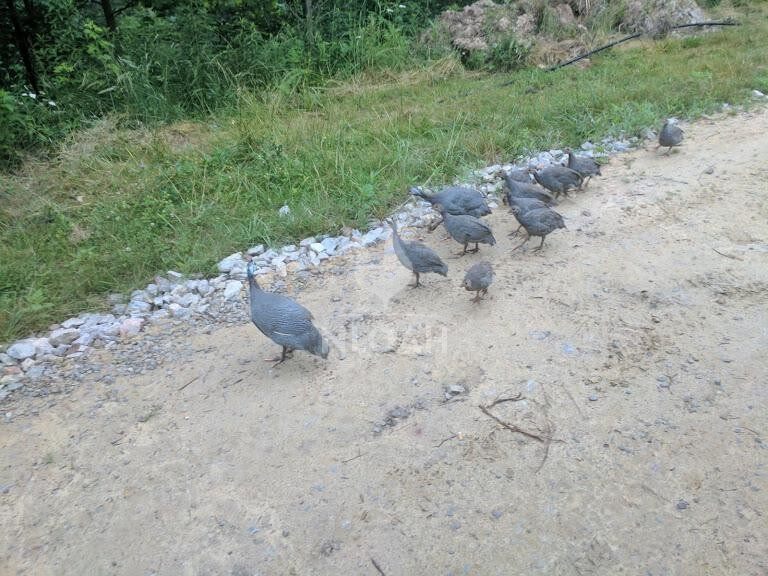
- Guinea hens generally begin laying their eggs in the months of April and May. Young hens might not start laying eggs until later on in June.
- Hens will usually disappear when they are laying and preparing to sit eggs, if they are not kept in the coop and run with your chickens. They often build a nest way up in a tree, and diligently sit their future offspring.
- Because guineas prefer to lay their eggs in the trees or woods, there is a high clutch loss rate to egg-stealing predators.
- The fertility rate of a guinea hen usually decreases when she is forced to live in a confined area.
- Guinea cocks remain robust mating partners until they are about five years of age.
- Like chicken hens, guineas also enjoy a nice dirt bath. But, unlike chickens, guineas prefer to find a natural indentation in the ground with dirt loose enough for them to flop about in to cleanse their bodies of mites and other parasites.
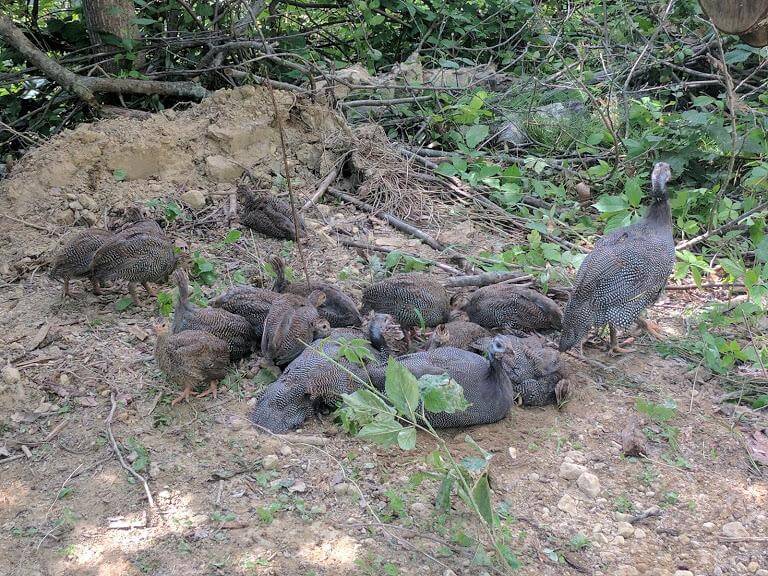
- Never keep guineas with only a chicken rooster. If a rooster does not have a hen to mate with it will try to mate with a guinea hen. Such a scenario could be deadly for a female guinea. If the guinea hen does survive and produce live offspring, the poultry bird will be sterile and closely resemble a little prehistoric vulture.
- For guinea flock serenity as well as best breeding practices, keep no more than one guinea cock per every three hens if the birds are going to be living in confinement or your homestead is on small acreage.
- Guineas absolutely cannot be snatched by the leg to be caught like chickens. Their legs are more fragile. Such an attempt at catching a guinea can often result in a broken leg. The easily startled birds will frantically try to break free of your grasp, and can injure their leg further as well as their beaks as they peck anything within reach repeatedly and as hard as possible to get loose. If you must catch a guinea to treat a medical issue or for another essential safety reason, grasp it firmly yet gently around its back, holding both wings down against its body.
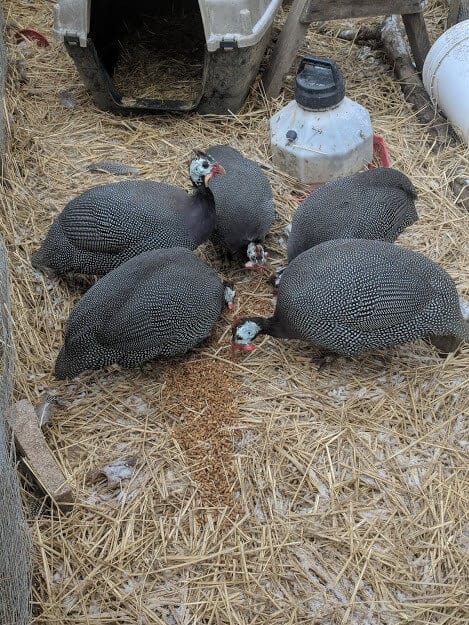
Can You Keep Guineas In The Suburbs?
Short answer – probably not. Guineas are loud birds, I mean they get really loud. The constant activity in a suburban environment would cause the guineas to launch into attack mode every time a neighbor walks a dog down the sidewalk or the mailman arrives.
Even if you keep the guineas in a run with the chickens, they will still give in to their natural urges, and sound the warning bell and rush around in a panic trying to ward off an attack.
A cage guinea will not likely be a happy or calm guinea. While cocks are not typically aggressive like roosters, they are highly territorial and take their protective duty seriously.
Guineas want room to roam, and tall perches to sit upon while on perimeter patrol. They remain ever vigilant for the appearance of a hawk or that dreaded chicken killer – the mink.
For these same reasons, keeping guineas on a small acreage homestead with neighbors nearby and property boundaries that are expected to be respected, could be problematic.
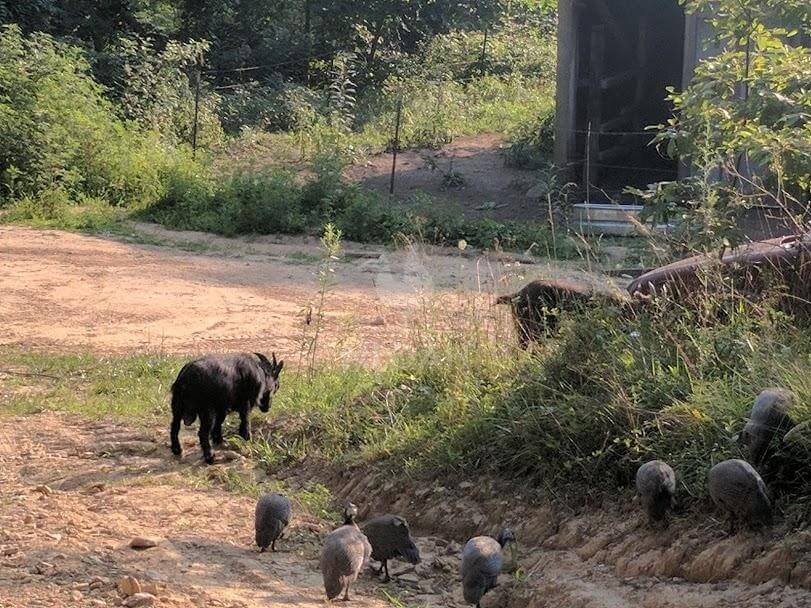
Guineas not only possess an innate drive to protect their fellow flock members, but can become guardians of other barnyard livestock as well. In the photo above you see some of our guinea flock trailing around behind a few goats while pecking the ground for something to eat.
If a fox or coyote attempts to get near the larger barnyard livestock, the dutiful guineas will be sure to let you know about it.
Guinea Training
As soon as the guinea keets leave their indoor or small brooder, it is essential that they begin their flock integration and boundary training.
Many guinea keepers recommend keeping the guineas in a large brooder or their own run next to the chicken coop for up to 4 months before letting them loose. It is vital that the guineas and the chickens and/or ducks (or even turkeys) they will be tasked with protecting, can see each-other.
The close situation of the separate living quarters for the guineas and the chicken coop run will give all of the birds plenty of time to get acquainted and not view each-other as a threat.
This becomes especially important if your rooster is a bit territorial and high-strung himself. The younger you can introduce the guineas to the entire flock, the better. A rooster is far less likely to feel threatened by guineas it has been around since they were keets.
I always keep several roosters in my flock, as well as multiple drakes. All of my poultry birds share a habitat and free range together.
Even when my rather affectionate White Leghorn rooster, Flock Leader (deemed a violent devil by everyone but me) was alive, I never had a problem with him sharing space with either guineas or ducks due to my flock introduction routine.
Although it varies due to seasonal temperatures, I only keep guineas separated in their own hutch for about three weeks before allowing them to become full-fledged members of the flock and free range.
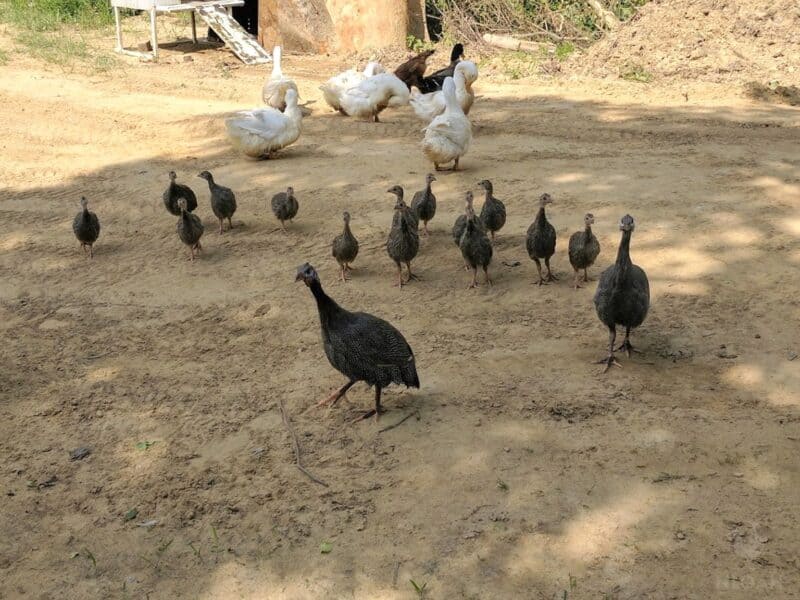
In my personal experience, this is long enough for all of the birds to get acquainted, for them to view me as a trusted source of food and safety, and to learn their free ranging boundaries.
Each evening I offer healthy “put up” treats to all of the barnyard inhabitants. They know I will be arriving before dusk for beak, bill, and hoof count. All of livestock free ranges within our 56-acre fenced homestead.
The nightly meeting routine allows me to make sure everyone is accounted for, and to do quick health checks before tucking them all into coops or stalls for the night.
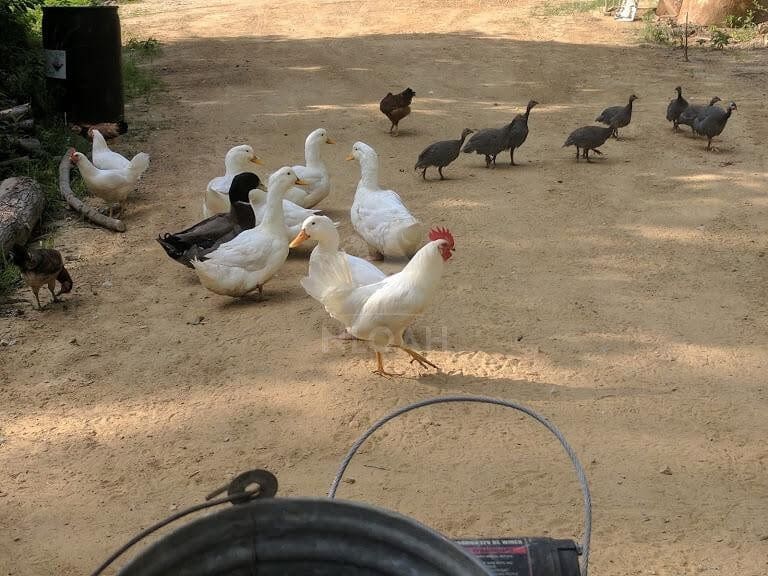
Some guinea keepers clip the wings of the birds to prevent them from flying away or choosing to simply walk away and relocate themselves permanently in the woods. This is not a method I either personally subscribe to or recommend.
Clipping the wings of guineas should not be necessary if you follow the training techniques noted above. A guinea with wings clipped can become extremely agitated because it cannot satisfy its natural urges to perch itself as high as possible above the barnyard while on flock security patrol.
Since the whole point of keeping guineas is nearly always to protect your meat and egg birds, intentionally limiting their own ability to do so just doesn’t make sense.
When given the choice, male guineas may prefer to sleep on the chicken run entrance door frame or even on top of the coop. One of our male guineas often chooses to sleep on the barn roof since it is higher, and provides a better vantage point of the entire barnyard – I am figuring.
Typically, I allow the guineas to perch where they prefer at night unless a big winter storm is coming, and I worry about losing them to inclement weather. Guineas may prefer one spot for a while, then switch to another, possibly because of a potential threat in a particular area.
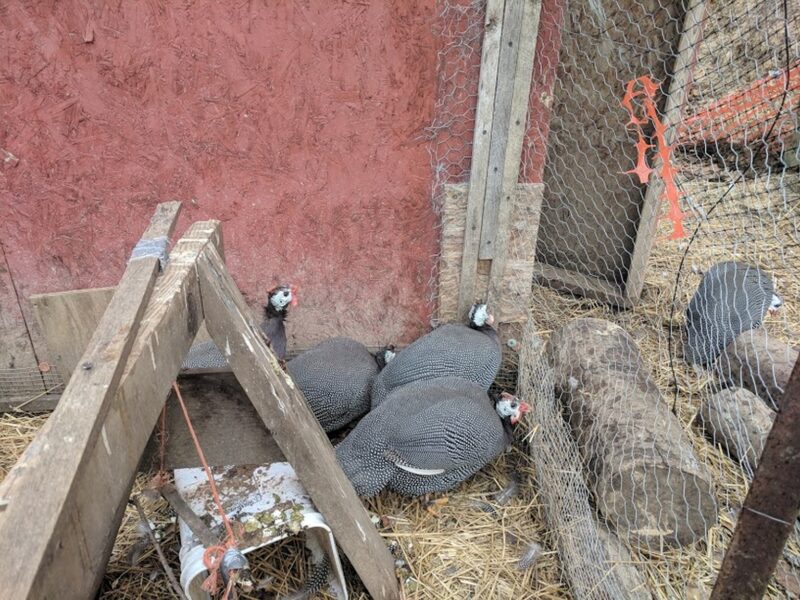
Guinea Habitat
As already notice in this guinea keeping guide, your little assassins can live right inside the same coop and run with chickens and ducks – once they are mature.
Day old guineas are far smaller and more fragile than their chick and duckling counterparts. I never, ever, keep keets with chicks after hatching phase of their development. The chicks tend to be far too rough and tumble for the keets, even when they are equal in weight.
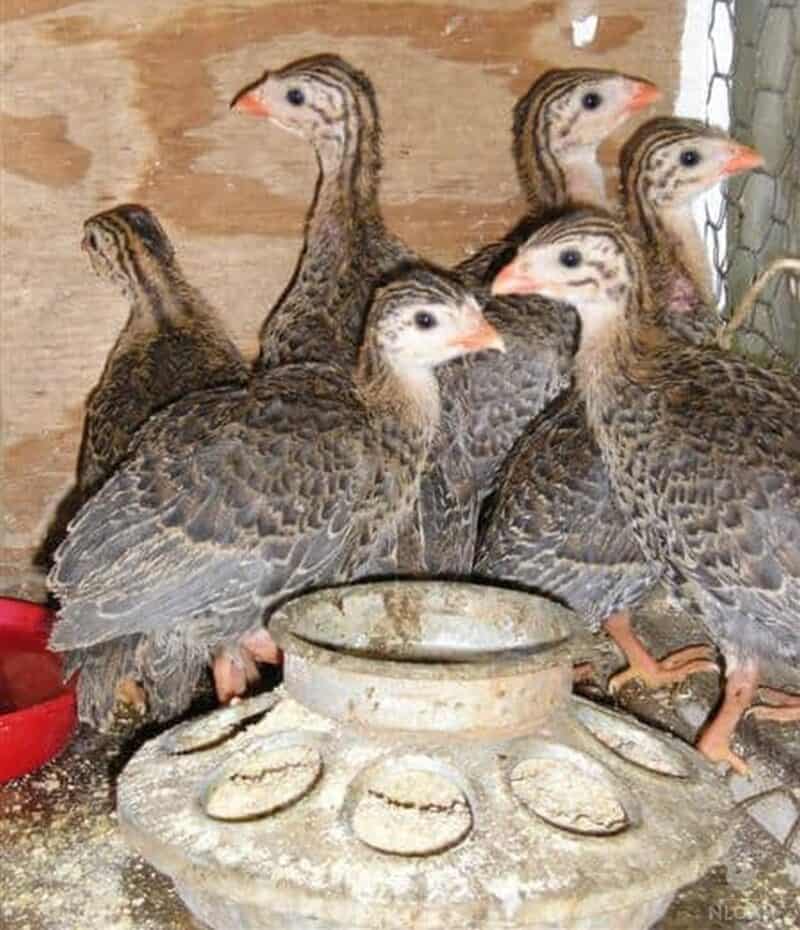
Keeping older chicks with older guineas, however, is fine:
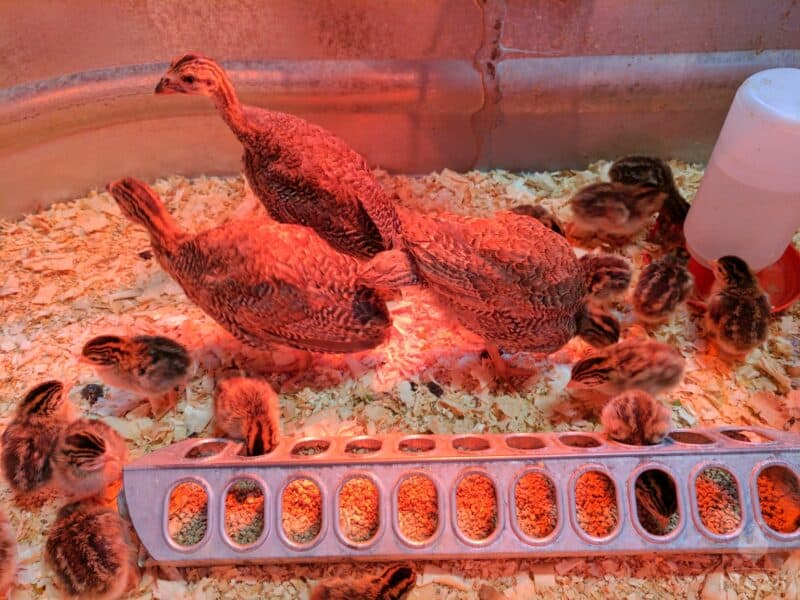
I have, however, kept keets and ducklings together. The ducklings are far less aggressive, and rarely ever develop poor behavior even when bored inside of a brooder.
While ducklings do not have pointy beaks, they can still harm a guinea keet by tugging on their tiny wings with surprising strength using their own rounded beaks.
I’ve never personally had this happen with a guinea, but did see it happen between a tiny chick and a male duckling once, after the agressive little chick repeatedly pecked the duckling.
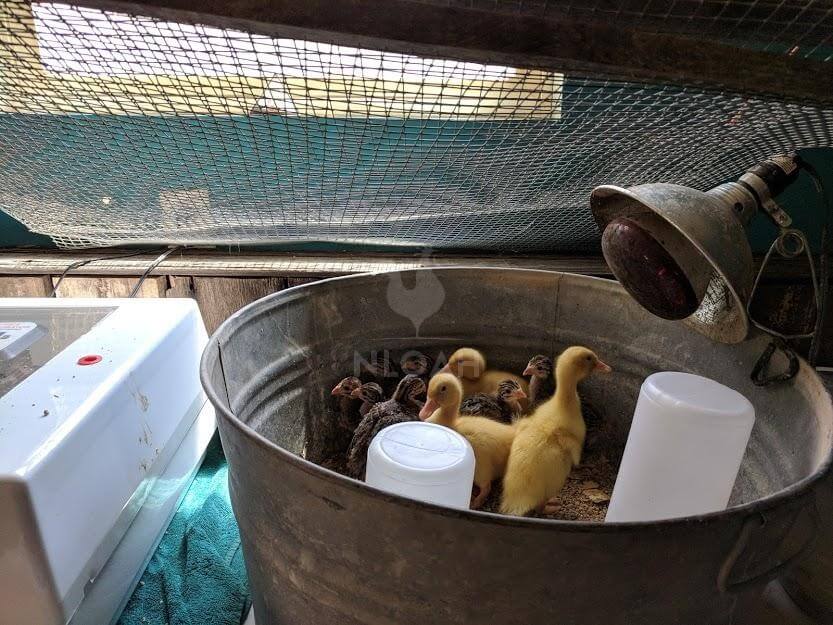
Guineas also need a heat lamp, clean waterer, feeder, and clean bedding that is regularly refreshed. I highly recommend using red heat lamps instead of clear or white ones.
The red light masks any blood on the keets caused during their great egg breakout or from pecking. When a guinea sees blood, it could peck at the wound further and make it worse, just like chickens.
I keep my brooder temperature around 95 to 97 degrees in the “hot area” for guineas just like I do for chickens and ducks. The brooder MUST have a cool area so the birds don’t get overheated.
The water should be kept in the cool area as well as the food. The poultry bird food can become overly exposed to moisture if kept in the hot area. Waterers or feeders exposed the direct heat from the lamp could also catch on fire if made of plastic, or cause the metal on the containers to become so hot they injure the feet of the birds.
Reduce the brooder temperature by five degrees per week until it hits room or outdoor temperature before removing the guineas from the brooder. If you are hatching guineas in the late spring or summer, the time they need to remain in the brooder will be decidedly shorter than it is during a fall or winter hatch.
Even when cultivating keets in the spring and early summer, remain mindful about dropping temperatures at night which could chill the young poultry birds.
Guineas hate living in or even entering dark places. When first introducing guineas to chicken coop living or being kept in an outdoor brooder, hang a solar light to help them acclimate to life in the great outdoors.
While keeping motion detector lights in your barnyard is a great idea to keep predators away, do not place one in the direction of the guinea brooder or they will not be able to sleep due to be constantly startled, and will become agitated.
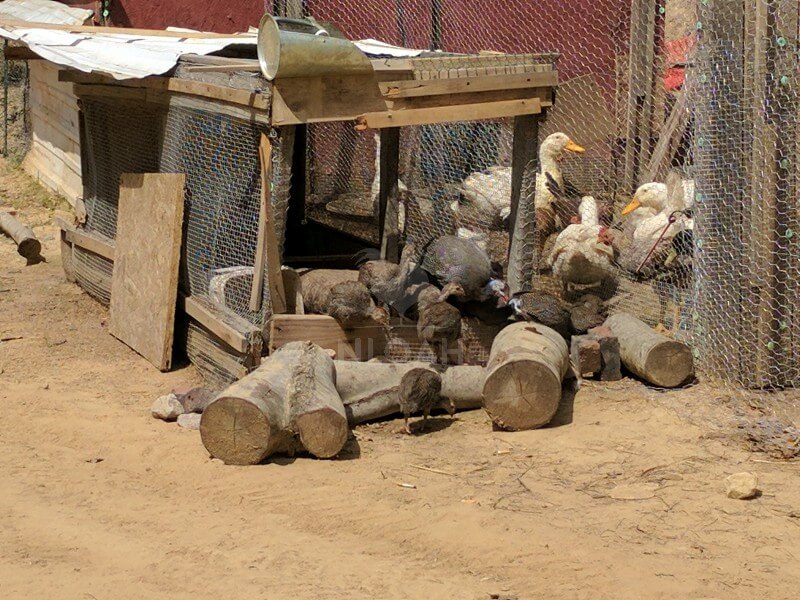
When you ultimately release the guineas from their outdoor brooder next to the chicken coop, simply remove or open the door and allow them to venture out at their own pace. It may take only seconds or even a couple of hours for all of the birds to take their first big steps of freedom.
Guineas are highly susceptible to dampness. Their outdoor brooder must have at least an area that is covered to keep rain and snow out. Place a dog box or a bucket inside the brooder and place bedding inside to give the guineas a clean space to warm up and sleep.
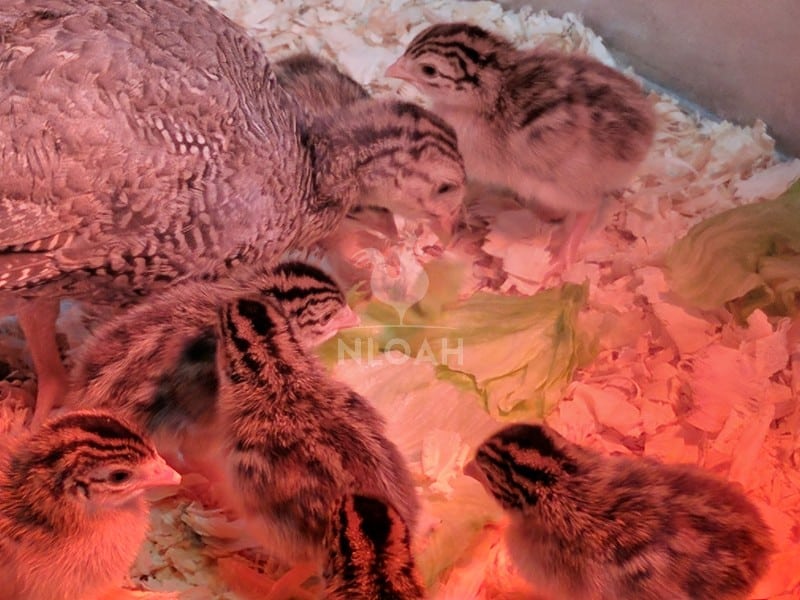
Unfortunately, the cuddling up together that guineas are prone to also can have dire results. When they get into their cuddle puddle, it’s not unusual to discover at least one guinea squished on the bottom of the pile.
I would love to say I have discovered a way to avoid such a tragedy, but I have not. Even if you put multiple small covered gathering areas in a brooder, the guineas will all still crowd into just one.
A large bucket or even a dog box used in a run or large brooder will still not prevent the squishing of guineas. Although ample space is available, the guineas will still bunch up together, starting in one corner.
This is one of the primary reasons I recommend buying far more guineas than you need to create an adequate flock.
Just like with chickens, hardware cloth and not chicken wire should be used in the outdoor guinea brooder. Chicken wire is only good for keeping birds in and not predators out.
Having chicken wire in a “day only chicken run” might be fine, but it is definitely not alright to use on a housing unit that must protect birds from predators at night – especially young ones.
I learned this lesson the hard way when i became a homesteader outside of a small town environment. Our first outdoor brooder was covered in chicken wire and place on top of barrels in an attempt to better protect the birds from burrowing predators.
Because the brooder was up against the chicken coop run, a mink climbed up the run fencing and onto the brooder. The vile little predator then reached its little arms into the brooder from the chicken wire and grabbed a hold of multiple guineas.
The mink was strong enough to hold the birds up against the fencing long enough to kill and eat on each of them. I imagine that time after time guineas situated a safe distance away ran over to attack the mink and became a meal.
Guinea Feed
- Guineas are avid foragers, even at a young age. They will provide the bulk of their own protein when allowed to free range – during all but the winter months.
- It is recommended to provide guineas with game bird feed instead of standard chicken feed because it has the 25% protein ratio keets need after advancing from chick starter crumble.
- Juvenile guineas need a poultry bird feed that has a 20% protein ratio.
- Mature guineas require a poultry bird feed with a 16% protein ratio.
- During the winter months or if keeping the flock of guineas in a confined space, increasing their protein slightly is recommended.
Guinea Breeding Hints And Tips
- Guinea mating pairs or a cock and his harem will usually shows signs of anxiety and stress when separate, hence the “come back, come back” call hens are known to make.
- Although you should never anticipate any signs of affection from your guineas, they do exhibit tenderness to their mates.
- As the temperature increases during the spring and summer seasons, so will the mating desires of the guinea cocks.
- Mature male guineas may become slightly aggressive with each other and especially juvenile males – or at least engage in posturing behavior as part of the mating dominance ritual.
- Mating between guineas may look a lot light fighting. The mature cock will first catch the hen and then tug on her back feathers until she submits to his desires.
- The guinea mating process is as intense as it is brief. If given the opportunity, a cock will select a spot with a bit of privacy to complete the mating ritual.
- If the chosen hen is able to escape the eager cock, he will chase her relentlessly, perhaps for an hour or more to catch her and do as he wishes. Flying into a tree and playing hide and seek will not deter a guinea male determined to mate.
- Once a guinea hen starts sitting on her eggs, the proud poppa guinea will almost always remain on tireless patrol around her next day and night until the eggs hatch. It is actually a beautiful thing to see – but don’t get too close, a typically docile cock will not welcome your visit.
- Guinea hens are capable of sitting up to 15 eggs in a single clutch.
- If a hen turns out to not be a diligent sitter or is killed, the eggs can be incubated if found within 10 days after being laid and not exposed to inclement weather – usually. If you keep Bantam hens (best egg sitters ever) they are often willing to take in orphaned eggs. However, because guinea eggs are more fragile and smaller than banty eggs, there is a good chance they could get crushed under their adoptive momma’s weight.
Guinea Incubation and Brooder Tips
- Guineas eggs are incubated for approximately 26 to 28 days.
- The temperature inside the incubator should be kept between 95 to 100 degrees.
- Cold water can be too much of a shock to a keet’s system. I recommend providing Lukewarm water to the hatchlings for the first week or so.
- To provide the keets with a bit of an energy boost, pour in 3 tablespoons of sugar to every single quart of water.
- Toss 1 pinch each of cinnamon and oregano onto feed or into a waterer about three times per week to help boost the immune system and respiratory system of the guinea keets. The guineas will love the added flavor of the herbs. You can also toss in a few pinches of dried calendula flowers as a weekly healthy and immune and circulatory system booster.
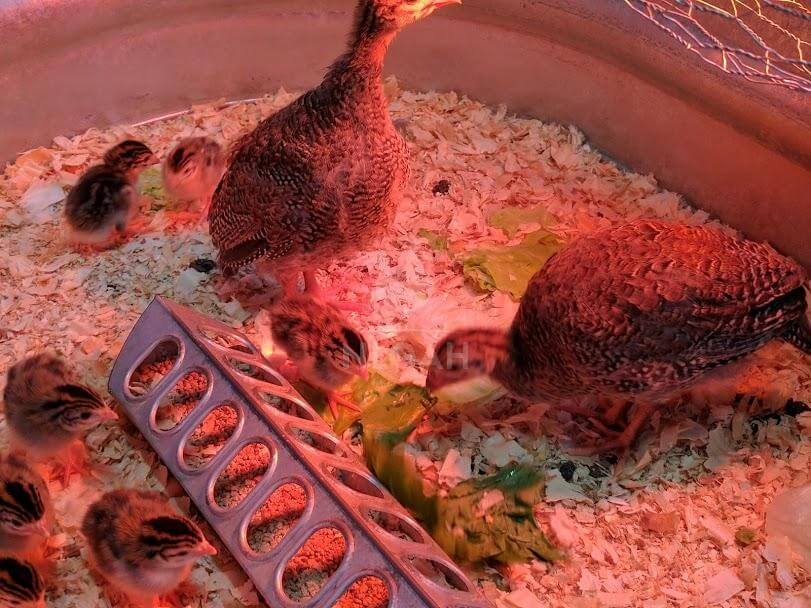
Lettuce is a great healthy training treat to offer young guineas. Refrain from offering treats of any kind to keets until they are at least two weeks old. The guineas on screen left are only a few days old. The guineas on the right are nearly two months old.
Grapes are also a favorite treat of guineas. They run around with little bits of grapes like they are playing football, it is hilarious to watch. But, only give fruit treats extremely sparingly.
Top 5 Popular Guinea Varieties
- Pearl Grays – This is the variety of guinea you are most likely to find in the United States. They have tan, black, and brown, feathers under their wings. These guineas also feature a wide black stripe and orange narrow stripes on their heads between the darker stripes. Pearl Gray guineas tend to be less high-strung than some other varieties.
- Coral Blues – This guinea variety have both light and dark blue striping on their back feathers as well as on top of their heads. Their legs, toes, and beaks also feature shades of light blue.
- Jumbo Lavenders – These guineas boast both dark blue stripes and light blue feathers. They also possess white spots and stripes on various parts of their feathered bodies.
- Standard Lavenders – The smaller lavender variety of guineas are nearly identical to the larger ones, but boast blue and white dots on some of their feathers and feature more orange on their toes, legs, an beaks.
- Slates – These guineas are rare in the fact that they do not have any stripes on their feathers. They are a shade purple-blue particularly around their necks.
Keeping guineas around your homestead will require very little extra work for you, no matter how many birds you add to the flock. They are highly independent and self-sufficient when provided freedom of movement and grassy or wooded areas to feed upon.
If you have been looking for a homesteading side-business to bring in a little extra money, guinea breeding might be ideal. Homesteaders and farmers eagerly search both locally and online for the birds to start or add to a flock.
As desirable as guineas are on agricultural land, they are still hard to find due to the difficulty in keeping them alive past the keet stage and their issues with mating in confinement.
If you decide to start a guinea breeding operation after becoming more experienced in their husbandry, build both a large and tall run and spacious and tall chicken coop cannot be recommended highly enough.
Simulate a free ranging environment as much as possible to help foster adequate mating and egg laying activities.
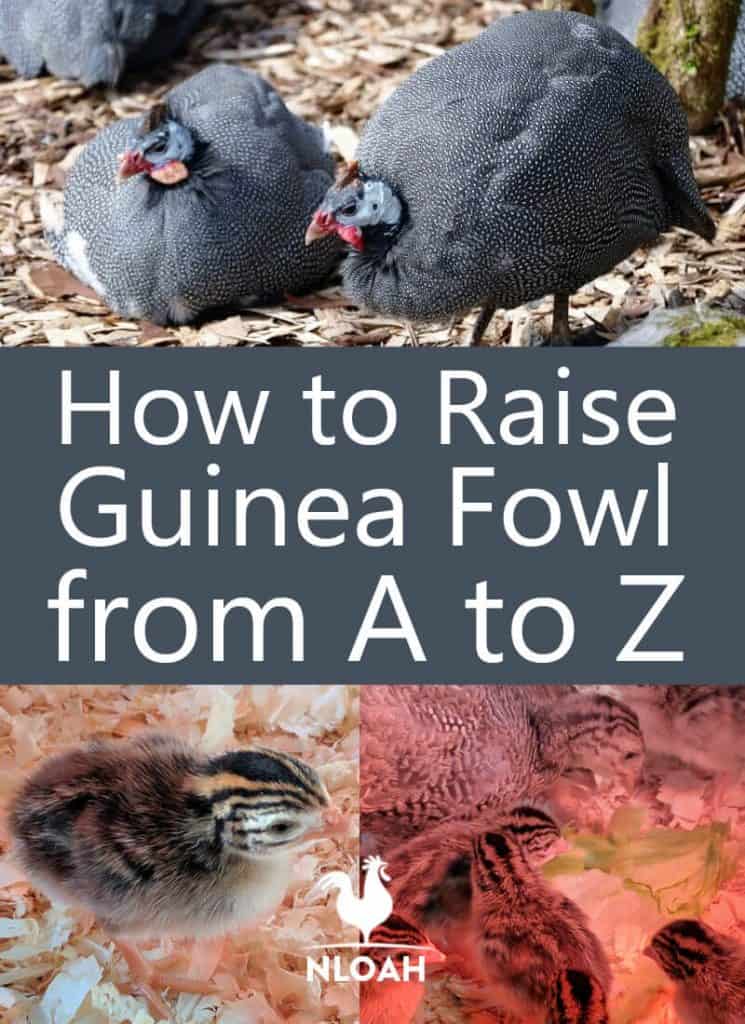

Tara lives on a 56 acres farm in the Appalachian Mountains, where she faces homesteading and farming challenges every single day, raising chickens, goats, horses, and tons of vegetables. She’s an expert in all sorts of homesteading skills such as hide tanning, doll making, tree tapping, and many more.

I have 9 four week old keeps. They have been in their coop for 2 weeks, but they will not go out into the fenced area on their own. We forced them out a couple of times and they stayed out all day and then went back in at dusk and would not come back out the next day. I want them to come outside during the day and in the coop at night. I will eventually let them free roam during the day and come back to the coop at night. How can I accomplish this?
What can I do to help my guineas grow faster other than more water(feed from co op), food, and a light? Is there anything I can feed them to Make them grow faster,bigger, fatter?
I have 5 week old guinea fowl who have spent the past 2 weeks in a coop in my barn. I desire to release them into the wild to get to eating ticks and am not concerned with their returning to the barn each night. I let them out two days ago and already cannot account for 3 guineas. Did I release them too early? At what age are they ready to be let wild?
I think 5 weeks is still too early.
And when releasing them, it should be done gradually by releasing a limited number like 2 or 3 at a go every 2 or so days.
That way, it encourages the released few to tend to keep around the coop and even try to come back to the rest of the flock when it gets dark.